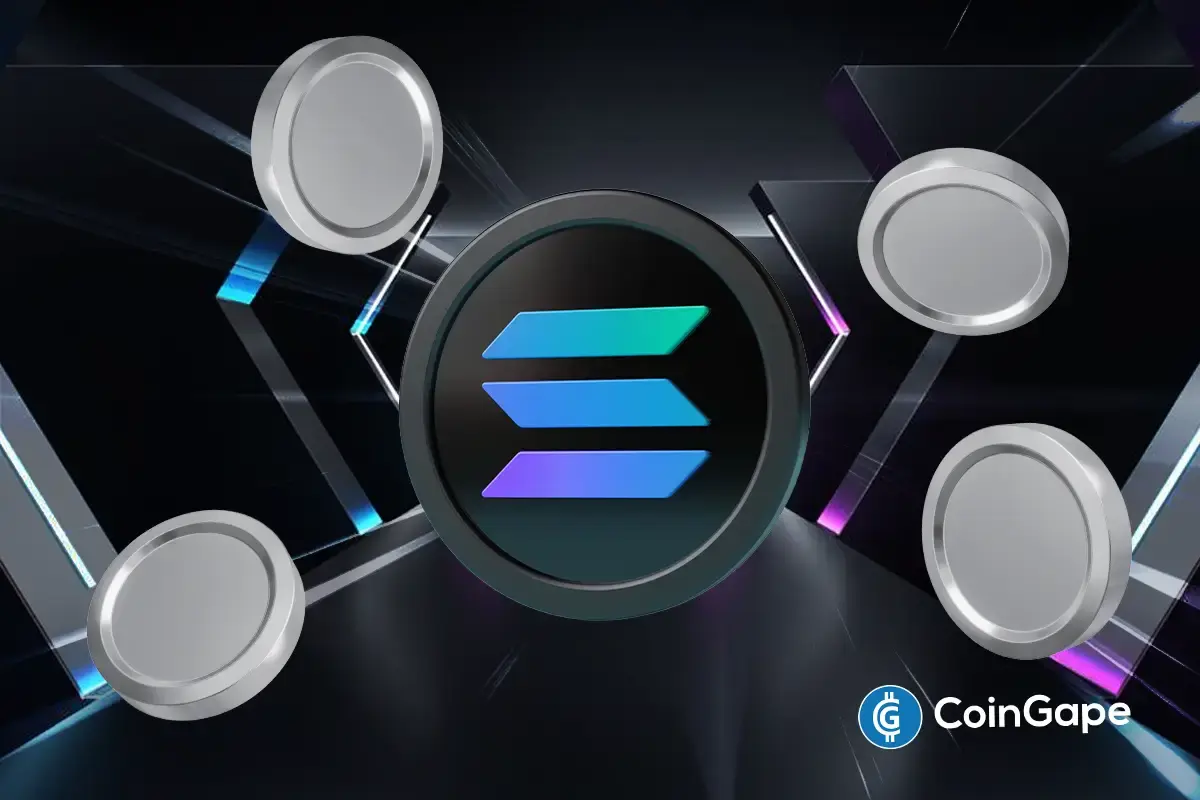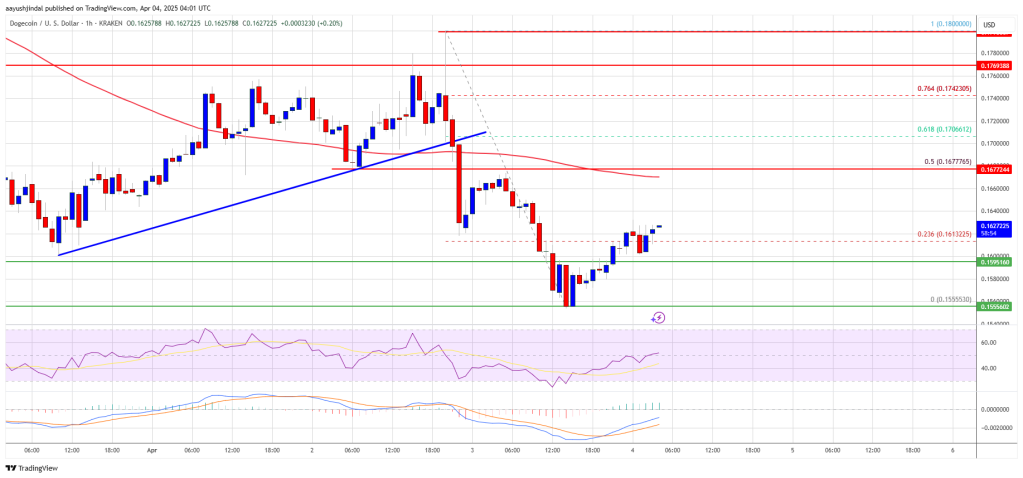Market
DOT Experiences 25% Price Drop in June Amid Bearish Pressure
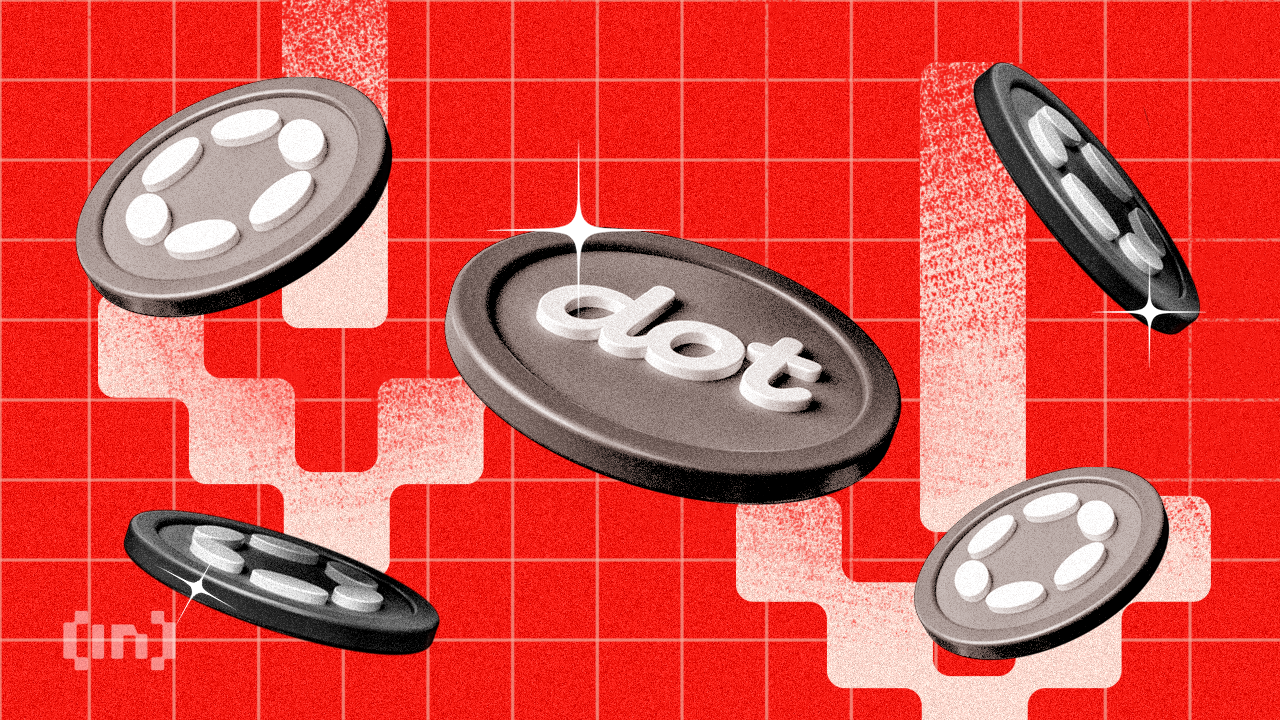
Polkadot faces bearish pressure as it struggles to maintain critical support levels, signaling potential further declines in its price action.
The goal of the analysis is to assess Polkadot’s bearish selling pressure, using Key Support and Resistance Levels, Market Sentiment, and Future Price Movements.
Polkadot Faces Bearish Pressure: Key Levels and Market Sentiment Analysis
Polkadot (DOT) has been experiencing a bearish trend, evident from the recent price action where it fell below critical support levels. The rejection from the Ichimoku Cloud and testing of lower support levels further emphasize this downtrend.
Following Bitcoin’s price drop to $64,700 yesterday, the price of DOT reached the important support level of $5.46. Subsequently, the price of DOT bounced upward, stabilizing around $5.80, as observed in the 4-hour chart.
DOT’s price has dropped 25% from its local high recorded on June 7
Read More: 5 Best Polkadot (DOT) Wallets To Consider In 2024
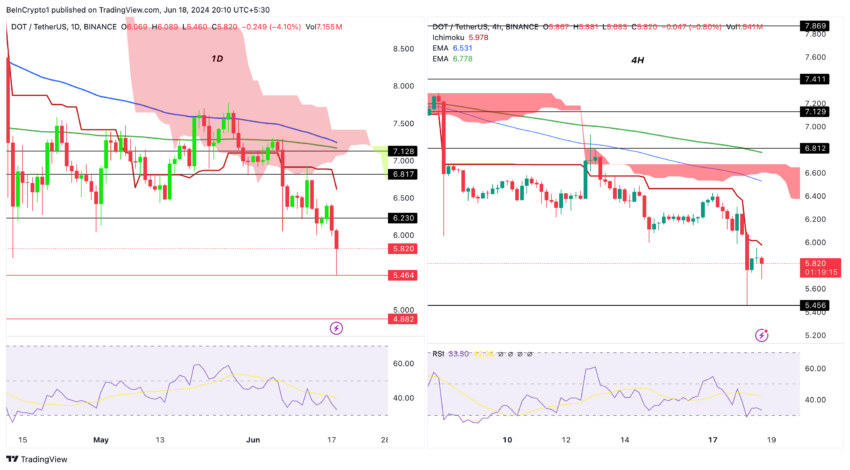
Currently, Polkadot faces several key support and resistance levels. Following our insights shared on BeInCrypto analysis, the DOT price managed to break below the $6.23 price level yesterday. This prompted the price to drop 12% in 2 days, underscoring and highlighting the importance of monitoring this price level. This price level should now act as a resistance level for DOT.
The Ichimoku Cloud analysis shows that the price action is clearly rejected from the cloud, indicating bearish sentiment. On the daily chart, the price is currently below the Ichimoku Cloud, suggesting strong bearish momentum. The baseline and conversion lines are trending downwards, which confirms the bearish outlook.
Similarly, on the 4-hour chart, the price is below the cloud, reinforcing the short-term bearish sentiment.
A breakdown below the current support at $5.46 could lead to further declines towards the next major support at $4.88. On the upside, the first major resistance to watch is $6.81. Reclaiming this level could indicate a potential reversal of the current downtrend.
To confirm a bullish reversal, higher resistance levels at $7.12 and $7.41 will also need to be broken through.
The moving averages also support the bearish outlook. The price is trading well below the 200 EMA, indicating a long-term bearish trend, and the 100 EMA is also above the current price, acting as a resistance level.
The Relative Strength Index (RSI) is trending towards the oversold territory, currently hovering around 30. This indicates increasing selling pressure. If the RSI drops below 30, it could signal potential further declines. Conversely, if it bounces off this level, it could indicate a short-term relief rally.
OI-Weighted Funding Rate Reflects Cautious Market Sentiment
Open Interest (OI) is the total number of outstanding derivative contracts, such as futures or options, yet to be settled. Higher OI indicates increased market participation and speculative activity, while lower OI suggests reduced trader engagement.
The funding rate is the periodic payment between traders holding long and short positions in perpetual futures contracts. Positive rates mean long positions pay shorts, indicating bullish sentiment, while negative rates mean shorts pay longs, indicating bearish sentiment.
The OI-weighted funding rate combines the funding rate with open interest, offering a detailed view of market sentiment. It shows whether sentiment is driven by many participants or just a few, helping to gauge the strength of market trends.
During June, the funding rate remained relatively stable and positive, indicating a bullish sentiment among traders. This period coincided with DOT’s price stability around the $7 mark. However, the market sentiment shifted around June 8 when the funding rate briefly turned negative, suggesting increased short positions or a reduction in long positions.
From June 9 to June 15, the funding rate returned to positive territory, though with some fluctuations, reflecting a mixed but generally bullish sentiment. Notably, during this time, DOT’s price faced resistance around $7, experiencing multiple rejections. This suggests that while traders were willing to maintain long positions, the price struggled to break through this key resistance level, indicating potential exhaustion among buyers.
Read More: Polkadot (DOT) Price Prediction 2024/2025/2030
The most significant change occurred between June 16 and June 17, when both the funding rate and DOT’s price experienced sharp declines. The funding rate turning negative again reflects a bearish pressure, aligning with Polkadot dropping from around $6.50 to approximately $5.4. This period of heightened volatility and increased trading volume suggests panic selling or intensified shorting, reinforcing the bearish outlook.

Overall, the analysis of the OI-weighted funding rate indicates that traders are becoming more cautious, anticipating further declines. The reduced speculative activity, as evidenced by the decreasing funding rate, points to a market sentiment that is hesitant to take long positions at current levels.
Monitoring this indicator alongside key support and resistance levels can provide crucial insights for future price movements and market sentiment.
Strategic Recommendations
If Polkadot’s price continues to fall below the $5.45 level, it could trigger a significant cascade of liquidations and bearish selling pressure, potentially driving the price down to $4.88. The fact that Bitcoin remains above the $65,000 level suggests it is experiencing only a minor correction.
However, if Bitcoin’s price continues to decline and reaches $60,000, this could be very bearish for Polkadot and incentivize further price drops below $4.88.
A reversion back to $67,000 for Bitcoin could positively impact Polkadot, potentially driving its price back up to $6.23. If this level is broken, it could signal a possible reversal, allowing for further upward movement.
Disclaimer
In line with the Trust Project guidelines, this price analysis article is for informational purposes only and should not be considered financial or investment advice. BeInCrypto is committed to accurate, unbiased reporting, but market conditions are subject to change without notice. Always conduct your own research and consult with a professional before making any financial decisions. Please note that our Terms and Conditions, Privacy Policy, and Disclaimers have been updated.
Market
What to Expect on May 7

The highly anticipated Pectra upgrade will launch on the Ethereum (ETH) mainnet on May 7, 2025, after overcoming a series of technical challenges and delays in the testnet phase.
Ethereum developers announced the date during the All Core Developers Consensus (ACDC) meeting on April 3, 2025.
Pectra Upgrade Countdown Begins
The upgrade was initially slated for a tentative mainnet launch on April 30. However, Ethereum developers have postponed the launch by one week.
“We’ll go ahead and lock in May 7 for Pectra on mainnet,” Ethereum Foundation researcher Alex Stokes said.
In preparation for this, Stokes confirmed that client releases will be made available by April 21, ensuring that all users have the necessary updates and tools ahead of the mainnet launch. On April 23, a detailed blog post outlining the Pectra mainnet will be published.
The Pectra upgrade will introduce 11 Ethereum Improvement Proposals (EIPs) to enhance various aspects of the network. Notably, three EIPs are dedicated to improving the validator experience.
The first is EIP-7251. This will increase the staking limit for validators from 32 ETH to 2,048 ETH per validator. This change aims to enhance capital efficiency for large stakers and staking pools.
“This simplifies the staking experience, allowing users to manage multiple validators under one node instead of several,” an analyst remarked.
Moreover, EIP-7002 introduces execution-layer triggerable withdrawals, giving validators more control. Meanwhile, EIP-6110 reduces the deposit processing delay from about 9 hours to just 13 minutes.
The upgrade will also include EIP-7702, a major step toward account abstraction. It allows Externally Owned Accounts (EOAs) to gain smart contract functionality while maintaining simplicity. This enables features like transaction batching, gas sponsorship (where third parties pay fees), passkey-based authentication, spending controls, and asset recovery mechanisms.
Finally, the upgrade increases blob capacity through EIP-7691. In addition, EIP-7623 helps manage the increased bandwidth requirements. These updates aim to make Ethereum more scalable, efficient, and user-friendly.
It is worth noting that the road to the mainnet launch has not been without hurdles. Two previous tests on the Holesky and Sepolia test networks failed to finalize properly. However, Pectra achieved full finalization on the Hoodi testnet on March 26, marking a significant milestone toward the successful deployment of the upgrade.
Despite the technical progress, ETH continues to face market challenges.

Data from BeInCrypto shows that ETH dropped 4.8% over the past week, with weekly losses extending to 17.1%. At the time of writing, the altcoin was trading at $1,822, reflecting a small daily gain of 0.8%.
Disclaimer
In adherence to the Trust Project guidelines, BeInCrypto is committed to unbiased, transparent reporting. This news article aims to provide accurate, timely information. However, readers are advised to verify facts independently and consult with a professional before making any decisions based on this content. Please note that our Terms and Conditions, Privacy Policy, and Disclaimers have been updated.
Market
XRP Futures and Illinois Lawsuit Relief

Coinbase filed with the US Commodity Futures Trading Commission (CFTC) to launch futures contracts for Ripple’s XRP token.
The move comes after a positive development for the crypto derivatives market in the US, reflecting shifting regulatory ties in the country.
Coinbase Files for XRP Futures Trading With CFTC
Coinbase Derivatives has submitted a filing to self-certify XRP futures. It will provide a regulated, capital-efficient means for market participants to gain exposure to XRP. The new contract could go live as soon as April 21.
“We’re excited to announce that Coinbase Derivatives has filed with the CFTC to self-certify XRP futures – bringing a regulated, capital-efficient way to gain exposure to one of the most liquid digital assets. We anticipate the contract going live on April 21, 2025,” read the announcement.
Meanwhile, the official filing indicates that the XRP futures contract will be a monthly cash-settled and margined contract trading under the symbol XRL.
Each contract represents 10,000 XRP and will be settled in US dollars. Trading will be available for the current month and two subsequent months. As a protective measure, trading will be temporarily halted if the spot XRP price moves more than 10% within an hour.
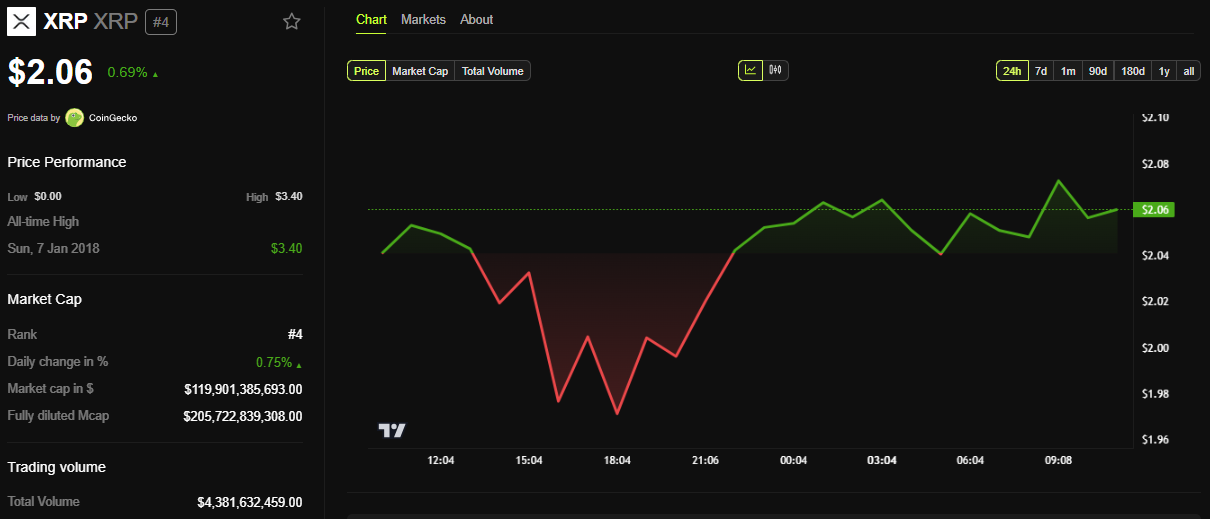
The Coinbase Exchange also confirmed that it has engaged with Futures Commission Merchants (FCMs) and other market participants. Both references reportedly expressed support for the launch.
However, Coinbase is not the first US-based exchange to introduce regulated XRP futures. In March, Chicago-based Bitnomial launched what it advertised as the country’s first CFTC-regulated XRP futures contract.
For Coinbase, however, the boldness comes after the CFTC eased key regulatory hurdles for crypto derivatives trading. As BeInCrypto reported, this signaled a more accommodating stance towards the sector.
“Pursuant to Commodity Futures Trading Commission (“CFTC” or “Commission”) Regulation 40.2(a), Coinbase Derivatives, LLC (the “Exchange” or “COIN”) hereby submits for self-certification its initial listing of the XRP Futures contract to be offered for trading on the Exchange…,” an excerpt in the filing indicated.
This suggests that the commodities regulator’s shift, revoking previous crypto-related guidelines, may boost institutional confidence. For XRP, this development bolsters confidence in the asset’s previously contentious status following Ripple’s recent regulatory breakthrough.
“Coinbase Derivatives’ filing with the CFTC to self-certify XRP futures aims to legitimize XRP trading by offering a regulated, capital-efficient product for investors,” one user remarked.
The futures contract might also help the odds of XRP ETF approval. Recently, the SEC delayed several applications to create one, and its status is in limbo.
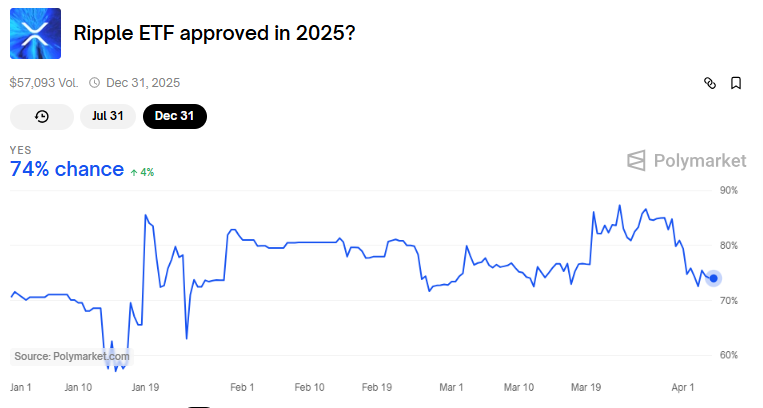
Data on Polymarket shows bettors see a 74% chance for XRP ETF approval in 2025 and a more modest 34% by July 31.
Regulatory and Legal Developments Favor Coinbase
Elsewhere, the timing of this filing aligns with recent favorable regulatory developments for Coinbase. Reports suggest Illinois intends to drop its lawsuit against the exchange over its staking services.
Up to 10 states filed a lawsuit against Coinbase in June 2023 alleging that its staking program constituted unregistered securities offerings.
This recent development makes Illinois the fourth state to withdraw legal action against Coinbase. Vermont, South Carolina, and Kentucky also dismissed their cases on March 13, 27, and 31, respectively.
However, the cases remain active in Alabama, California, Maryland, New Jersey, Washington and Wisconsin.
These legal retreats coincide with the US SEC’s (Securities and Exchange Commission) February decision to abandon its federal lawsuit against Coinbase. BeInCrypto reported that this development marked a broader shift in the regulatory approach under the current administration.
“Regulators are losing steam, and Coinbase is stacking quiet courtroom wins. Staking’s future in the US might just be back on track,” a user commented.
Illinois’ decision to drop its lawsuit comes as the state advances a Bitcoin strategic reserve bill. Specifically, Illinois State Representative John M. Cabello introduced House Bill 1844 (HB1844), highlighting Bitcoin’s potential as a decentralized, finite digital asset.
“A strategic bitcoin reserve aligns with Illinois’ commitment to fostering innovation in digital assets and providing Illinoisans with enhanced financial security,” the bill read.
Disclaimer
In adherence to the Trust Project guidelines, BeInCrypto is committed to unbiased, transparent reporting. This news article aims to provide accurate, timely information. However, readers are advised to verify facts independently and consult with a professional before making any decisions based on this content. Please note that our Terms and Conditions, Privacy Policy, and Disclaimers have been updated.
Market
Dogecoin (DOGE) Bleeds Further—Fresh Weekly Lows Test Investor Patience

Dogecoin started a fresh decline from the $0.180 zone against the US Dollar. DOGE is consolidating and might struggle to recover above $0.1680.
- DOGE price started a fresh decline below the $0.1750 and $0.170 levels.
- The price is trading below the $0.1680 level and the 100-hourly simple moving average.
- There was a break below a key bullish trend line forming with support at $0.170 on the hourly chart of the DOGE/USD pair (data source from Kraken).
- The price could extend losses if it breaks the $0.1550 support zone.
Dogecoin Price Dips Again
Dogecoin price started a fresh decline after it failed to clear $0.180, like Bitcoin and Ethereum. DOGE dipped below the $0.1750 and $0.1720 support levels.
There was a break below a key bullish trend line forming with support at $0.170 on the hourly chart of the DOGE/USD pair. The bears were able to push the price below the $0.1620 support level. It even traded close to the $0.1550 support.
A low was formed at $0.1555 and the price is now consolidating losses. There was a minor move above the 23.6% Fib retracement level of the downward move from the $0.180 swing high to the $0.1555 low.
Dogecoin price is now trading below the $0.170 level and the 100-hourly simple moving average. Immediate resistance on the upside is near the $0.1650 level. The first major resistance for the bulls could be near the $0.1680 level. It is near the 50% Fib retracement level of the downward move from the $0.180 swing high to the $0.1555 low.
The next major resistance is near the $0.1740 level. A close above the $0.1740 resistance might send the price toward the $0.180 resistance. Any more gains might send the price toward the $0.1880 level. The next major stop for the bulls might be $0.1950.
Another Decline In DOGE?
If DOGE’s price fails to climb above the $0.170 level, it could start another decline. Initial support on the downside is near the $0.160 level. The next major support is near the $0.1550 level.
The main support sits at $0.150. If there is a downside break below the $0.150 support, the price could decline further. In the stated case, the price might decline toward the $0.1320 level or even $0.120 in the near term.
Technical Indicators
Hourly MACD – The MACD for DOGE/USD is now losing momentum in the bearish zone.
Hourly RSI (Relative Strength Index) – The RSI for DOGE/USD is now above the 50 level.
Major Support Levels – $0.1600 and $0.1550.
Major Resistance Levels – $0.1680 and $0.1740.
-

 Market20 hours ago
Market20 hours agoBitcoin’s Future After Trump Tariffs
-

 Market24 hours ago
Market24 hours agoIP Token Price Surges, but Weak Demand Hints at Reversal
-

 Ethereum23 hours ago
Ethereum23 hours agoEthereum Trading In ‘No Man’s Land’, Breakout A ‘Matter Of Time’?
-

 Market23 hours ago
Market23 hours agoHBAR Foundation Eyes TikTok, Price Rally To $0.20 Possible
-

 Altcoin23 hours ago
Altcoin23 hours agoJohn Squire Says XRP Could Spark A Wave of Early Retirements
-

 Market22 hours ago
Market22 hours ago10 Altcoins at Risk of Binance Delisting
-

 Market21 hours ago
Market21 hours agoEDGE Goes Live, RSR Added to Roadmap
-

 Regulation19 hours ago
Regulation19 hours agoUS Senate Banking Committee Approves Paul Atkins Nomination For SEC Chair Role



